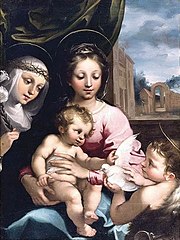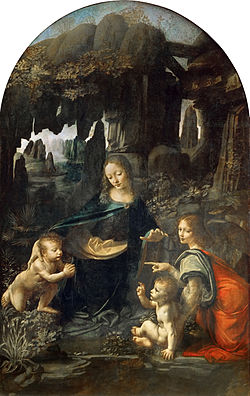| The Holy Family | |
|---|---|
| Greek: Η Αγία Οικογένεια, Italian: Sacra Famiglia | |
 | |
| Artist | Panagiotis Doxaras |
| Year | 1700 |
| Medium | oil on canvas |
| Movement | Heptanese School |
| Subject | Joseph, Virgin Mary, Christ Child, and John the Baptist with angels |
| Dimensions | 70.1 cm× 58.9 cm(27.6 in× 23.2 in) |
| Location | National Gallery of Athens, Athens, Greece |
| Owner | National Gallery of Athens |
| Accession | K.866 |
| Website | Official Website |
The Holy Family is an oil painting created by Greek painter Panagiotis Doxaras. He was a prominent member of the Heptanese School. He was also an author. His son Nikolaos Doxaras was also a famous painter. Panayiotis was from a small village named Koutifari, close to Kalamata. He moved to Zakynthos at a young age. He studied painting with famous painter Leos Moskos. He traveled all over the Venetian empire with the famous artist including Venice. He studied painting in Venice for five years. He became a theoretical painter. He wrote several books on painting. He traveled all over the Ionian Islands. He lived in Lefkada, Zakynthos, and Corfu. He frescoed the ceiling of Panagia Faniromeni in Zakynthos. Eighteen of his paintings survived. [1] [2]
Contents
Panagiotis successfully introduced oil painting into the Greek style. Greek patrons rejected Renaissance-style paintings such as the works of Titian, Tintoretto, and El Greco. Most of the patrons were Greek churches that preferred the Greek style or maniera greca. Italian and Greek patrons also supported the old style. Some of Panayioti's works resemble the Byzantine-influenced Cretan School mixed with the early Heptanese school. He was not successfully able to introduce Renaissance-style paintings but the artist began to introduce slower drying oil paint replacing egg tempera. He was also able to resemble Michael Damaskinos in creating a new movement for Greek painters to follow. [3]
The Holy Family is a topic used by countless Greek and Italian painters. Venetian masters such as Titian and Tintoretto painted versions of the Holy Family. El Greco also covered the subject matter in several of his pieces. Historians agree that some paintings are a depiction of the family resting on the flight into egypt. Panayioti's studied countless paintings. He translated Trattato de la pittura de Leonardo da Vinci. He was an admirer of Leonardo da Vinci. His work is a mixture of Leonardo da Vinci and Raphael's Holy Family paintings. Panagioti's was also influenced by the works of Rutilio di Lorenzo Manetti. Although Doxara's Italian Renaissance-style paintings were not as popular as his Greek-style works. The artist's painting style and theories were appreciated during the Modern Greek art movement in the 19th century. His masterpiece is part of the collection of the National Gallery of Athens in Greece. [4]



